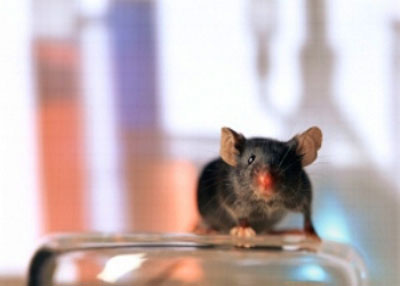|

by Alasdair Wilkins
May 06, 2012
from
io9 Website

Some laboratory mice were given specially engineered
insulin-producing genes. These genes were then remotely activated
using radio waves. This could mean a whole new field of medical
procedures in which we turn genes on and off at will.
This breakthrough is the work of geneticists at New York's
Rockefeller University.
It's a pretty circuitous path from the
initial burst of radio waves to the activation of the gene, and
there's still a lot of refinement and improvement that needs to be
made before this can be used in medical treatments, but still -
we're talking about the ability to modify the behavior of genes
without ever going inside a patient's body.
That's a potentially colossal advance.
Admittedly, while the treatment itself is totally non-invasive, the
researchers did first have to inject some
nanoparticles onto the mice's cells
in order to affect their genes.
It's a bit of a complex process, but
Nature has a good explanation of just what was involved:
Friedman and his colleagues coated
iron oxide nanoparticles with antibodies that bind to a modified
version of the temperature-sensitive ion channel TRPV1, which
sits on the surface of cells.
They injected these particles into
tumors grown under the skins of mice, then used the magnetic
field generated by a device similar to a miniature
magnetic-resonance-imaging machine to heat the nanoparticles
with low-frequency radio waves.
In turn, the nanoparticles heated
the ion channel to its activation temperature of 42°C. Opening the channel allowed calcium
to flow into cells, triggering secondary signals that switched
on an engineered calcium-sensitive gene that produces insulin.
After 30 minutes of radio-wave exposure, the mice's insulin
levels had increased and their blood sugar levels had dropped.
The radio waves are ideal for this sort
of remote manipulation because they can pass through thick layers of
tissue, and they can be easily focused by the TRPV1 channel to
affect only the desired target.
Lead researcher Jeffrey Friedman
says that, although this particular treatment had to do with insulin
production, this isn't actually meant specifically as a diabetes
treatment.
That's a good thing, considering this
treatment is massively more inefficient than many diabetes
treatments currently available. Instead, this is just meant as a
general proof of concept, and insulin production happens to be one
of the easier gene activities to manipulate.
Even better, the researchers have already developed a way to achieve
similar, albeit weaker, results without having to inject
nanoparticles at all.
They have developed cells that can grow
their own required nanoparticles, meaning there would be no need to
give patients strange chemicals or molecules. However,
as Nature
explains, this would still require growing tumors inside humans to
actually get these cell cultures in place, which means the treatment
isn't yet ethically permissible in humans.
It's definitely early days yet, but this
is one seriously intriguing line of research.
Remote-Controlled Genes
...Trigger
Insulin Production
by Helen Shen
03 May 2012
from
Nature Website
Nanoparticles heated by
radio waves
switch on genes in mice

Radio waves
remotely triggered the release of insulin in mice.
GEORGE STEINMETZ/SCIENCE PHOTO LIBRARY
Researchers have remotely activated genes inside living animals, a
proof of concept that could one day lead to medical procedures in
which patients’ genes are triggered on demand.
The work, in which a team used radio waves to switch on engineered
insulin-producing genes in mice, is published today in Science.1
Jeffrey Friedman, a molecular geneticist at the Rockefeller
University in New York and lead author of the study, says that in
the short term, the results will lead to better tools to allow
scientists to manipulate cells non-invasively. But with refinement,
he thinks, clinical applications could also be possible.
Friedman and his colleagues coated iron oxide nanoparticles with
antibodies that bind to a modified version of the
temperature-sensitive ion channel TRPV1, which sits on the surface
of cells.
They injected these particles into tumors grown under the
skins of mice, then used the magnetic field generated by a device
similar to a miniature magnetic-resonance-imaging machine to heat
the nanoparticles with low-frequency radio waves.
In turn, the nanoparticles heated the
ion channel to its activation temperature of 42°C. Opening the
channel allowed calcium to flow into cells, triggering secondary
signals that switched on an engineered calcium-sensitive gene that
produces insulin.
After 30 minutes of radio-wave exposure, the mice's insulin levels
had increased and their blood sugar levels had dropped.
Radio stars
“The great thing about this system
is that radio-wave heating can penetrate deep tissue, and TRPV1
can focus that stimulus very locally to just where you have the
nanoparticles,” says David Julius, a physiologist who studies
TRPV1 at the University of California, San Francisco.
Friedman says that his team did not
develop the method as a way of managing diabetes; insulin and blood
sugar levels simply provide convenient physiological readouts for
checking that the remote control is working.
“There are many good treatments for
diabetes that are much simpler,” he says.
However, the system could potentially be
engineered to produce proteins to treat other conditions.
In control experiments, the researchers showed that the radio waves
heated only cells that contained nanoparticles, and the heat neither
killed the specialized cells nor spread to neighboring, unmodified
ones.
“Magnetic fields are a good way to
develop enough energy without doing harm,” says Arnd Pralle, a
biophysicist at the State University of New York at Buffalo, who
has worked on stimulating neurons using nanoparticles heated by
radio waves. 2
However, he says, more research is
needed to characterize fully how the nanoparticles absorb, retain
and distribute heat.
Genetic therapy
The researchers also experimented with cultured cells genetically
engineered to make their own nanoparticles, and found that they
could stimulate a weaker insulin secretion in these cells, too.
“What I found most novel about this
is there’s no need for any chemicals or small molecules to be
administered,” says Ed Boyden, a neurobiologist at the
Massachusetts Institute of Technology in Cambridge, who helped
to pioneer a method of using fibre optics to control neural
activity with light.3
Friedman's current method is not
practical for use in the clinic because it is not ethical to grow
tumors in humans, so the researchers are planning to test
alternative delivery systems for the nanoparticles.
“I think people intuit that someday
nanotechnology will have an impact on human medicine,” says
Friedman. “We’ve extended the repertoire of what the particles
can do in living animals.”
References
-
Stanley, S. A., et al. -
Radio-Wave Heating of Iron Oxide
Nanoparticles Can Regulate Plasma Glucose in Mice
- Science
336, 604–608 (2012).
-
Huang, H., Delikanli, S., Zeng,
H., Ferkey, D. M. & Pralle, A. -
Remote control of ion channels and
neurons through magnetic-field heating of nanoparticles
- Nature Nanotechnol. 5,
602–606 (2010).
-
Boyden, E. S., Zhang, F.,
Bamberg, E., Nagel, G. & Deisseroth, K. -
Millisecond-timescale, genetically
targeted optical control of neural activity - Nature Neurosci. 8,
1263–1268 (2005).
|


